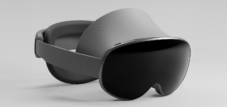Galaxy XR is official! Samsung's mixed-reality headset, running on Google's Android XR, starts at $1,799.99
Xpert pre-release
Language selection 📢
Published on: October 22, 2025 / Updated on: October 22, 2025 – Author: Konrad Wolfenstein

Galaxy XR is official! Samsung's mixed-reality headset, running on Google's Android XR, starts at $1,799 – Original image: Samsung / Creative image: Xpert.Digital
Samsung's invasion of the spatial future: The Galaxy XR as a Trojan horse against the platform hegemony of Meta (Quest) and Apple (Vision Pro)
When open systems challenge closed empires – The battle for the next computing era has begun
The announcement of the Samsung Galaxy XR on October 22, 2025, marks far more than the introduction of yet another mixed-reality headset into an already competitive market. With a starting price of $1,799, the South Korean company strategically positions itself between Meta's accessible Quest ecosystem and Apple's luxurious Vision Pro, but the real significance of this launch lies not in the hardware itself, but in the fundamental architecture on which it is based. The device is the first commercial product to run on Android XR, an entirely new operating system that Samsung co-developed with Google and Qualcomm. This alliance of three tech giants signals a concerted offensive against the closed ecosystems of Apple and Meta, and the choice of weapons in this battle could determine the future of spatial computing for the next decade.
The strategic importance only becomes fully apparent in the context of current market dynamics. Meta currently dominates the VR headset market with an overwhelming 74.6 percent market share in 2024, which even rose to 84 percent in the fourth quarter. This dominance is built on aggressive pricing and an established gaming ecosystem, but the overall market figures reveal a disturbing reality: Global VR headset shipments fell by 12 percent year-on-year in 2024, despite the launch of new models like the Quest 3S. Apple's Vision Pro, heralded with great media fanfare as a revolution in spatial computing, sold an estimated 420,000 to 500,000 units in its first year, well below the original expectations of 700,000 to 800,000 units. The extended reality market is at a critical inflection point where technological maturity meets a lack of mass-market interest.
Suitable for:
- Samsung Galaxy XR | The XR event on October 22: Why is Samsung announcing the "Worlds Wide Open" event for Project Moohan?
The architecture of openness as a competitive advantage
Samsung's decision to choose Android XR as its platform is a conscious strategic bet that open ecosystems will play the same role in the XR space as they do in the smartphone market. The parallels are unmistakable: Android captured over 70 percent of the global smartphone market by offering manufacturers and developers flexibility that Apple's iOS never allowed. Fragmentation, often considered a weakness of open systems, proved to be a strength in the long run, enabling innovation at all levels and fostering price competition. Android XR promises to transfer this dynamic to the world of extended reality.
The technical foundation of this strategy is OpenXR, a royalty-free, open standard from the Khronos Group that enables developers to create XR applications that work across a wide range of devices. Samsung emphasizes that all apps developed for Android will work immediately on the Galaxy XR, giving the device access to a massive application ecosystem at launch. Furthermore, developers already working with Unity, OpenXR, or WebXR can easily transfer their experiences to Android XR. This interoperability addresses the classic chicken-and-egg problem of new platforms: developers are reluctant to develop for platforms without users, while users avoid platforms without applications.
The economic implications of this architecture are significant. While Apple's closed visionOS ecosystem forces developers to optimize exclusively for Vision Pro, and Meta offers a larger ecosystem but also controls it proprietary, Android XR theoretically opens the door to true platform competition. Samsung is only the first hardware partner; other manufacturers will follow, potentially leading to a diversification of form factors, price points, and use cases. This horizontal expansion could significantly expand the overall market size rather than simply redistributing market share.
The economic reality of the premium segment
With a retail price of $1,799.99, the Galaxy XR positions itself in the upper mid-range of the market, significantly cheaper than the Vision Pro at $3,500, but considerably more expensive than the Quest 3S, which starts at $299. This pricing reflects a fundamental strategic decision: Samsung isn't targeting mass-market adoption, but rather early adopters and professional users willing to pay a premium price for superior technology.
The hardware specifications partially justify this positioning. The device uses Qualcomm's Snapdragon XR2+ Gen 2 processor, which offers a 15 percent higher GPU frequency and a 20 percent higher CPU frequency compared to the Snapdragon XR2 Gen 2, and supports displays with up to 4.3K resolution per eye at 90 frames per second. The built-in Micro-OLED displays, with a resolution of 3552 x 3840 pixels per eye and a total of 27 million pixels, theoretically even exceed the pixel density of the Vision Pro. However, at 545 grams, the Galaxy XR is heavier than many competitors, and its battery life of 2.5 hours for general use is on the lower end of what's acceptable for productive work scenarios.
The real innovation lies not in the raw hardware performance, but in the integration of multimodal artificial intelligence. Google's Gemini is integrated into Android XR at the system level, not as an afterthought. This fundamental design decision distinguishes the Galaxy XR from competitors, where AI features often feel like applications layered on top of the platform. Gemini understands the user's environment through the headset's cameras and microphones and can respond conversationally, as if it were a companion rather than a tool.
Practical use cases illustrate its potential: In Google Maps, Gemini can serve as a personal travel guide, providing recommendations for nearby locations while users navigate immersive 3D maps. While watching YouTube videos, users can ask Gemini to provide additional information about the content being shown, enabling learning-oriented experiences. The Circle to Search feature allows users to draw a circle around real-world objects with a single hand gesture and instantly obtain information about them. These features demonstrate how AI can fundamentally change the interaction with spatial interfaces, moving away from explicit commands toward natural, context-dependent dialogues.
The Enterprise Dimension: Where ROI becomes measurable
While consumer applications dominate the headlines, the immediate commercial potential of extended reality lies in the enterprise segment. Samsung has recognized this and announced a partnership with Samsung Heavy Industries to develop virtual shipbuilding training solutions. This collaboration is more than a prestige project; it addresses concrete operational challenges in heavy industry.
Samsung Heavy Industries has been using VR technology for safety training and plan reviews since 2018 and delivered a VR solution for crew training to Evergreen's headquarters in Taiwan in July 2025. The integration with Galaxy XR is intended to leverage multimodal AI, high-performance video passthrough, and real-time rendering technologies to further develop these solutions. The business logic is compelling: By virtually replicating the actual shipyard environment, engineers can perform design verification and maintenance simulations without having to be physically on-site. This reduces travel costs, accelerates iteration cycles, and enables repeatable training in high-risk scenarios without real-world danger.
Empirical studies on XR in an enterprise context deliver impressive ROI figures. Research shows that companies implementing XR solutions for quality assurance can achieve return on investment rates of 300 to 400 percent within 12 months. A concrete example: The Swedish construction company Skanska invested $75,000 in AR-supported quality assurance systems and achieved annual rework savings of $300,000, corresponding to an ROI of 400 percent. Remote collaboration solutions deliver similarly impressive figures, with travel cost savings of over $54,000 annually and a 30 percent reduction in project delays.
Forrester's analysis of mixed reality implementations documents a three-year ROI of 177 percent for decision makers. These figures explain why the commercial segment of the VR market grew by 14.9 percent in 2024, while consumer shipments declined. Companies can justify the cost of XR headsets through measurable productivity gains, error reduction, and accelerated training processes, while consumers base their purchase decisions primarily on entertainment and difficult-to-quantify lifestyle factors.
Qualcomm's partnership with Samsung to leverage Snapdragon Spaces technology aims to tap into the enterprise ISV ecosystem and provide developers with tools to build business solutions for Android XR. These collaborations bring enterprise-ready XR capabilities for advanced training, co-design of solutions, and secure remote collaboration. The fact that Samsung Heavy Industries has already validated the integration of its internally developed VR solution with Galaxy XR prior to the official market launch indicates a high level of platform maturity.
The competitive landscape: Meta, Apple and the coming consolidation
The XR market is undergoing intense competition, characterized by three fundamentally different strategic approaches. Meta pursues a volume leadership strategy through aggressive pricing and a focus on gaming and social interaction. Apple relies on technological superiority and seamless integration into its existing ecosystem, while accepting a small, high-priced market segment. Samsung and Google are positioning themselves with Android XR as an open alternative that aims to combine the advantages of both approaches: access to a broad ecosystem like Meta, coupled with premium hardware quality like Apple.
Market data clearly demonstrates the challenges of these strategies. Meta's overwhelming market dominance is based on over 20 million Quest headsets sold and an established gaming ecosystem, yet the company has invested billions into this market position. Meta's Reality Labs division reported operating losses of over $15 billion in 2024, while revenue from Quest titles increased by 12 percent, reaching over $2 billion cumulatively. These figures illustrate the long-term nature of the investment: Meta is effectively subsidizing hardware to achieve ecosystem lock-in.
Apple's Vision Pro demonstrates the limitations of a premium-only strategy. Despite excellent hardware and considerable media attention, the device failed to achieve mass market adoption. Analysts attribute this to the combination of high price, limited content offerings, and unclear value proposition for the average consumer. Interestingly, the Vision Pro showed stronger adoption in the enterprise segment, where the price can be justified by measurable productivity gains. Reports document use in medical operations, product development, and architectural visualization, where the high display quality and precise hand tracking provide direct benefits.
Samsung and Google's bet on Android XR theoretically addresses the weaknesses of both competing strategies. By positioning themselves between Meta and Apple, they appeal to both price-sensitive enthusiasts and quality-conscious professionals. The open platform should accelerate content development and enable hardware diversification, while the Gemini integration delivers a unique value proposition. The biggest unknown remains Google's long-term commitment: The company has a reputation for prematurely ending projects, from Google Glass to Stadia to Google Plus. Developers and users will be skeptical until Android XR proves it's more than just another experimental Google project.
🗒️ Xpert.Digital: A pioneer in the field of extended and augmented reality
Galaxy XR: Samsung's bet on an open XR future
The global market context: Growth despite fragmentation
The extended reality market presents a fascinating dichotomy between optimistic long-term forecasts and sobering short-term realities. Various market research firms project a market size of between $25.1 and $86.2 billion for 2025, depending on definition and methodology, with growth rates between 23 and 33.2 percent CAGR through 2033. These considerable discrepancies in forecasts reflect uncertainty about the pace of adoption and the question of which form factors will prevail.
Geographically, North America dominates, accounting for an estimated 37 to 40 percent of the global market, driven by early technology adoption, robust technological infrastructure, and the presence of leading technology companies. However, the Asia-Pacific region shows the highest growth potential, with projected CAGRs of over 31 percent. China plays a particularly interesting role here: The country is developing a distinct XR ecosystem with strong participation from major internet companies, smart device manufacturers, and emerging players. The rapid commercialization of generative AI technology in China creates a unique foundation for AI eyewear growth.
Europe is showing mixed signals: While the region is technologically advanced and has strong industrial use cases, consumer adoption is slower than in the US. Germany, France, and the UK represent the strongest European markets, with estimated combined revenues of over three billion dollars in 2025. Regulatory frameworks, particularly data protection standards such as GDPR, significantly influence product development and could make Europe a preferred test market for privacy-focused XR solutions.
Market segmentation by form factor reveals key trends. Standalone headsets, which require no external connection to PCs or smartphones, are increasingly dominating and are expected to account for 60 percent of consumer sales by 2026. Tethered headsets, which connect to powerful PCs, retain their niche for high-end gaming and professional applications. The most exciting category is AI glasses with no or minimal displays, which rely on voice-based and audible interaction. Omdia predicts this market will grow from 5.1 million units in 2025 to 35 million units by 2030, driven by products like Ray-Ban's Meta glasses.
Suitable for:
- Samsung Galaxy XR – Revolution in the mixed reality market: This headset is supposed to outshine the Apple Vision Pro
The Smart Glasses Dimension: Samsung's Second Frontal Attack
Samsung's XR strategy isn't limited to the Galaxy XR headset. At the end of the announcement event, the company hinted at partnerships with eyewear manufacturers Warby Parker and Gentle Monster to develop AI-powered smart glasses. This announcement is strategically significant because it signals Samsung's commitment to the full spectrum of XR form factors, from immersive headsets to everyday wearables.
Ray-Ban's Meta glasses have proven that a market for smart glasses without displays exists. EssilorLuxottica reported that two million units have been sold since its launch in October 2023, with sales tripling in the first half of 2025. The company plans to increase production capacity to ten million units annually by the end of 2026. These figures demonstrate real consumer demand for wearables that seamlessly integrate technology into everyday accessories.
Warby Parker and Gentle Monster represent different market segments. Warby Parker, known for its direct-to-consumer model and stylish, affordable eyewear, targets a broad, mainstream-oriented market. Google is investing up to $150 million in the partnership, $75 million for product development, and another $75 million as a direct investment. Gentle Monster, a South Korean brand known for avant-garde design and fashion collaborations, targets a high-fashion segment and particularly appeals to Generation Z. Google holds a 4 percent stake in Gentle Monster, representing an investment of approximately €107 million.
These partnerships signal a fundamental shift in strategy from previous smart glasses attempts like Google Glass. Instead of technology-first design, which ignores social acceptance, Samsung and Google prioritize design and fashion. The glasses are intended to be glasses that people enjoy wearing first, and technological devices second. This reversal of priorities addresses one of the fundamental barriers to adoption of previous smart glasses attempts: social stigma and lack of aesthetic appeal.
The planned features will likely follow Ray-Ban Meta's approach: cameras for photo and video capture, open-ear speakers for audio, microphones for voice control, and Gemini integration for context-aware AI assistance. Possible additional features could include small displays for notifications and navigation, similar to Google's prototypes shown at I/O 2025. Android XR integration should enable seamless connectivity with Galaxy XR headsets and other Android devices.
Market forecasts and economic implications
Samsung's business prospects depend on the successful execution of several parallel strategies. In the headset segment, the Galaxy XR must prove that it is more than just another "me-too" product. The combination of powerful hardware, an open platform, and deep AI integration theoretically offers a compelling value proposition, but reality shows that technical superiority alone is rarely enough. Success will depend on whether Samsung and Google can create an ecosystem of applications that leverage the unique capabilities of Android XR.
The enterprise segment offers the most likely path to early profitability. Companies have clear use cases, measurable ROI expectations, and the financial capacity to pay premium prices. Samsung's existing enterprise relationships, combined with Google's cloud and AI infrastructure, create a strong foundation for B2B adoption. The partnership with Samsung Heavy Industries is just the beginning; similar collaborations in the automotive, aerospace, healthcare, and logistics sectors are likely.
In the consumer segment, market development is more uncertain. The $1,799.99 price limit rules out mass-market adoption in the short term, but positions the device for enthusiasts and professionals willing to pay for quality. Samsung has proven with the Galaxy smartphone line that it can successfully market premium Android products; the question is whether this brand strength can be transferred to a new product category.
The most interesting long-term development is the potential creation of true ecosystem competition in the XR space. If more hardware manufacturers adopt Android XR, a dynamic similar to the smartphone market could develop: manufacturers compete on hardware innovation and price, while the platform provides continuity and compatibility. This could accelerate innovation, lower prices, and ultimately enable mass-market adoption. The alternative is fragmentation, where each manufacturer creates subtly different implementations of Android XR, frustrating developers and weakening the ecosystem.
Technological convergence and social implications
The integration of extended reality, artificial intelligence, and spatial computing represents more than a technological evolution; it could fundamentally change how people interact with digital information. The traditional computing paradigm is based on flat displays and explicit input methods: mouse, keyboard, touchscreen. Spatial computing with AI integration promises a more natural interface where speech, gaze, and gestures become the primary modes of interaction.
The potential productivity gain is significant. Studies on spatial computing in the workplace document that users benefit from virtually unlimited virtual monitors and the ability to organize information three-dimensionally. SAP research on Vision Pro shows that immersive environments enable employees to minimize distractions and switch between different tasks more quickly. The ability to manipulate digital twins of physical systems enables more intuitive system analysis and collaborative design reviews.
At the same time, significant societal concerns exist. Data protection issues are particularly acute for devices that continuously record and analyze the user's environment. The integration of AI exacerbates these concerns: If Gemini sees what the user sees and hears what the user hears, new dimensions of data collection and potential misuse emerge. European regulators will undoubtedly conduct close scrutiny, and the GDPR could impose restrictions on certain features.
Social acceptance remains an open question. While AR glasses without displays, such as the Ray-Ban Meta, are becoming increasingly socially acceptable, full-featured headsets continue to elicit mixed reactions. The idea of people being fully immersed in virtual worlds in shared physical spaces provokes unease about social isolation and loss of reality. These concerns are not trivial; they reflect fundamental questions about the role of technology in human relationships.
The health effects of long-term XR use are not yet fully understood. Eye strain, neck, and head discomfort were reported by early Vision Pro users. Ergonomically optimizing XR devices for multiple hours of daily use remains a challenge. Samsung's design choices, such as separate batteries, removable light shields, and ergonomic weight distribution, partially address these concerns, but the two- to three-hour battery life continues to limit long-term use.
The strategic horizon: What comes after Galaxy XR
Samsung's XR offensive is part of a broader transformation of the computing landscape. The company is positioning itself not only in the headset market, but is creating a cohesive ecosystem of connected devices: smartphones, tablets, wearables, smart glasses, and XR headsets, all integrated by Android and enhanced by AI. This multi-device strategy reflects the belief that the future of computing will not be dominated by a single form factor, but by seamless flow between different devices, depending on context and task.
Google's role in this strategy is central. As the developer of Android XR and Gemini, Google controls the platform intelligence, while Samsung and other manufacturers deliver hardware innovation. This division of labor could be highly effective, but it also carries risks. If Google shifts strategic priorities or reduces its commitment to Android XR, hardware partners would be at risk. The long-term stability of this partnership will be critical to the success of the ecosystem.
Qualcomm's position as a silicon supplier gives the company significant influence over development direction. The Snapdragon XR roadmap determines which features future devices will support. Qualcomm's focus on AI acceleration, lower latency, and higher resolutions aligns the industry toward specific use cases. The collaboration between Qualcomm, Google, and Samsung in defining Android XR demonstrates a high level of strategic coordination that is rare in the technology industry.
The next phase of development will likely prioritize miniaturization and improved energy efficiency. The vision of long-term wearable AR glasses with all-day battery life and form factors indistinguishable from regular eyeglasses remains the ultimate goal. The technological hurdles are significant: Displays must become brighter and more energy-efficient, processors more powerful while drastically reducing power consumption, and optical systems must become thin enough to fit into standard eyeglass frames. Micro-LED displays, neuromorphic processors, and advanced photonics will likely be central technologies in this evolution.
Conclusion: The bet on an open future
Samsung, Google, and Qualcomm's joint initiative with Galaxy XR and Android XR represents a fundamental bet that the future of spatial computing will be open, diverse, and AI-powered. This vision stands in direct contrast to Apple's vertical integration and Meta's proprietary ecosystem. The history of the technology industry offers examples of both approaches succeeding: Apple's closed iPhone ecosystem coexists with Android's open smartphone market; Windows dominated PCs through openness, while Apple's Mac maintained a profitable niche.
Whether Android XR will play the same role in the XR market as Android does in the smartphone market depends on execution on several levels. Samsung must deliver hardware that is technically competitive and attractive to the target audience. Google must prove that Gemini integration delivers real added value beyond gimmicks. Developers must be persuaded to build for Android XR, which requires clear business models and development tools. Most importantly, the ecosystem must produce applications that people actually want to use, that solve real problems, or open up new possibilities.
The launch of the Galaxy XR on October 22, 2025, is not the end of a development, but the beginning of a long competition that will define the next era of computing. The next 18 to 24 months will show whether Samsung's vision of an open, AI-powered XR future becomes reality or whether market dynamics develop that favor closed ecosystems or entirely different form factors. For investors, developers, and companies, the message is clear: The battle for spatial computing has only just begun, and the battle lines are drawn between openness and control, between hardware diversity and ecosystem integration, between technology feasible today and the vision of fully augmented reality.
Your global marketing and business development partner
☑️ Our business language is English or German
☑️ NEW: Correspondence in your national language!
I would be happy to serve you and my team as a personal advisor.
You can contact me by filling out the contact form or simply call me on +49 89 89 674 804 (Munich) . My email address is: wolfenstein ∂ xpert.digital
I'm looking forward to our joint project.
☑️ SME support in strategy, consulting, planning and implementation
☑️ Creation or realignment of the digital strategy and digitalization
☑️ Expansion and optimization of international sales processes
☑️ Global & Digital B2B trading platforms
☑️ Pioneer Business Development / Marketing / PR / Trade Fairs
🎯🎯🎯 Benefit from Xpert.Digital's extensive, five-fold expertise in a comprehensive service package | BD, R&D, XR, PR & Digital Visibility Optimization

Benefit from Xpert.Digital's extensive, fivefold expertise in a comprehensive service package | R&D, XR, PR & Digital Visibility Optimization - Image: Xpert.Digital
Xpert.Digital has in-depth knowledge of various industries. This allows us to develop tailor-made strategies that are tailored precisely to the requirements and challenges of your specific market segment. By continually analyzing market trends and following industry developments, we can act with foresight and offer innovative solutions. Through the combination of experience and knowledge, we generate added value and give our customers a decisive competitive advantage.
More about it here:























